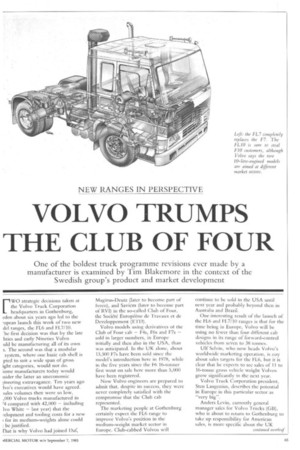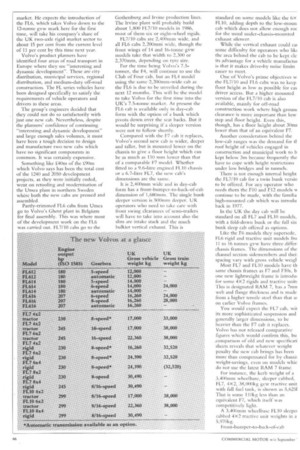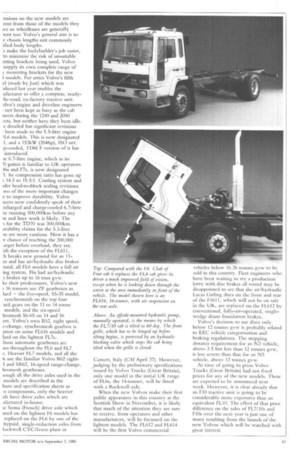VOLVO TRUMPS THE CLUB OF FOUR
Page 67

Page 68

Page 69

If you've noticed an error in this article please click here to report it so we can fix it.
One of the boldest truck programme revisions ever made by a manufacturer is examined by Tim Blakemore in the context of the Swedish group's product and market development
rWO strategic decisions taken at the Volvo Truck Corporation headquarters in Gothenburg, eden about six years ago led to the -opean launch this week of two new del ranges, the FL6 and EL7/10. he first decision was that by the late hties and early Nineties Volvo uld be manufacturing all of its own s. The second was that a modular system, where one basic cab shell is ptcd to suit a wide span of gross ight categories, would not do. lome manufacturers today would isider the latter an uneconomic ;ineering extravagance. Ten years ago lvo's executives would have agreed. sales volumes then were so low, ,000 Volvo trucks manufactured in '4 compared with 42,000 — including Ivo White — last year) that the 7elopment and tooling costs for a new 1 for its medium-weights alone could : be justified.
[hat is why Volvo had joined Dar, Magirus-Deutz (Later to become part of lveco), and Saviern (later to become part of RVI) in the so-called Club of Four, the Societe Europeene de Travaux et de Deyeloppement (Eli)).
Volvo models using derivatives ot the Club of Four cab — F4s, F6s and F7s — sold in larger numbers, in Europe initially and then also in the USA, than was anticipated. In the UK alone, about 13,500 F7s have been sold since the model's introduction here M 1978, while in the five years since the F6 16-tonner first went on sale here more than 5,000 have been registered.
Now Volvo engineers are prepared to admit that, despite its success, they were never completely satisfied with the compromise that the Club cab represented.
The marketing people at Gothenburg certainly expect the FL6 range to improve Volvo's position in the medium-weight market sector in Europe. Club-cabbed Volvos will continue to be sold in the USA until next year and probably beyond then in Australia and Brazil.
One interesting result of the launch of the FL6 and FL7/10 ranges is that for the time being in Europe, Volvo will be using no fewer than four different cab designs in its range of forward-control vehicles from seven to 38 tonnes.
Ulf Selvin, who now heads Volvo's worldwide marketing operation, is coy about sales targets for the FL6, but it is clear that he expects to see sales of 11 to 16-tonne gross vehicle weight Volvos grow significantly in the next year.
Volvo Truck Corporation president, Sten Langenius, describes the potential in Europe in this particular sector as "very big".
Anders Levin, currently general manager sales for Volvo Trucks (GB), who is about to return to Gothenburg to take up responsibility for American sales, is more specific about the UK market. He expects the introduction of the FL6, which takes Volvo down to the 12-tonne gvw mark here for the first time, will take his company's share of the UK two-axle rigid market sector to about 15 per cent from the current level of 11 per cent by this time next year.
Volvo's product planners have identified four areas of road transport in Europe where they see "interesting and dynamic development". These are city distribution, municipal services, regional distribution, and medium-duty off-road construction. The FL series vehicles have been designed specifically to satisfy the requirements of vehicle operators and drivers in these areas.
The group's engineers decided that they could not do so satisfactorily with just one new cab. Nevertheless, despite the planners' confidence of continuing "interesting and dynamic development" and large enough sales volumes, it must have been a tough decision to design and manufacture two new cabs which have no significant components in common. It was certainly expensive.
Something like £40m of the i9Om which Volvo says has been the total cost of the 1240 and 2050 development projects, as they were initially coded, went on retooling and modernisation of the Umea plant in northern Sweden where both the new cabs are pressed and assembled.
Partly-trimmed FL6 cabs from Umea go to Volvo's Ghent plant in Belgium for final assembly. This was where most of the development work on the FL6 was carried out. FL7/10 cabs go to the Gothenburg and Irvine production lines. The Irvine plant will probably build about 1,800 FL7/10 models in 1986, most of them six or eight-wheel rigids.
FL7/10 cabs are 2,400mm wide, and all FL6 cabs 2,200mrri wide, though the front wings of 14 and 16-tonne gvw models take that width to 2,300 or 2,370mna, depending on tyre size.
For the time being Volvo's 7.5tonner, the F4, will continue to use the Club of Four cab, but an FL4 model using the same 2,200mm-wide cab as the FL6 is due to be unveiled during the next 12 months. This will be the model to take Volvo for the first time into the UK's 7.5-tonne market. At present the FL6 cab is available only in day-cab form with the option of a bunk which pivots down over the seat backs. But it would be surprising if a sleeper version were not to follow shortly.
Compared with the F7 cab it replaces, Volvo's second new cab is wider, deeper and taller, but is mounted lower on the chassis to give a floor height which can be as much as 110 mm lower than that of a comparable F7 model. Whether fitted to a 9.6-litre engined FLIO chassis or a 6.7-litre FL7, the new cab's dimensions are the same.
It is 2,400mm wide and in day-cab form has a front-bumper-to-back-of-cab dimension of 1,680mm. The single bunk sleeper version is 500mm deeper. UK operators who need to take care with front swing clearances of semi-trailers will have to take into account also the slim are intake stack and the much bulkier vertical exhaust. This is standard on some models like the 6x FL10, adding depth to the low-moun cab which does not allow enough roc for the usual under-chassis-mounted exhaust silencer.
While the vertical exhaust could car some difficulty for operators who lik( the area behind the cab to be kept cle its advantage for a vehicle manufactui is that it makes drive-by noise limits easier to meet.
One of Volvo's prime objectives w the FL7/10 and FL6 cabs was to keep floor height as low as possible for cas driver access. But a higher mounted version of the FL7/10 cab is also available, mainly for off-road construction work where high groom clearance is more important than low step and floor height. Even this, though, has a floor height about 3Orm lower than that of an equivalent F7.
Another consideration behind the low-cab ranges was the demand for tl roof height of vehicles engaged in construction and municipal work to b kept below 3m because frequently the have to cope with height restrictions under low bridges and in tunnels.
There is not enough internal height the FL7/10 cab for a twin bunk vcrsio to be offered. For any operator who needs them the F10 and F12 models vk continue to be made, with the familia high-mounted cab which was introdu back in 1977.
In the UK the day cab will be standard on all FL7 and FL10 models, with a fold-down bunk or the full sin bunk sleep cab offered as options.
Like the F6 models they supersede, PLO rigid and tractive unit models fro 11 to 16 tonnes gvw have three differ chassis frames. The dimensions of the channel section sidemembers and theii spacing vary with gross vehicle weigl Most FL7 and FL10 models have th same chassis frames as F7 and FlOs, b one new lightweight frame is introdm for some 4X2 rigids and tractive unit.: This is designated RAM 7, has a 7mn web and flange thickness and is made from a higher tensile steel than that on earlier Volvo frames.
You .would expect the FL7 cab, wit its more sophisticated suspension and generally larger dimensions, to be heavier than the F7 cab it replaces. Volvo has not released comparative figures which would confirm this, bu .comparison of old and new specificati sheets reveals that whatever weight penalty the new cab brings has been more than compensated for by chassi: weight-savings, even on models whic do not use the latest RAM 7 frame.
For instance, the kerb weight of a 3,400inin wheelbase, sleeper cabbed, FL7, 4x2, 38,000kg gcw tractive unit with full fuel tank, is shown as 5,6251 That is some 110kg less than an equivalent F7, which itself was competitively light.
A 3,400mm wheelbase FL10 sleepei cabbed 4x2 tractive unit weights in a 5,970kg.
Front-bumper-to-back-of-cab msions on the new models are rent from those of the models they ice so wheelbases are generally rent too: Volvo's general aim is to e chassis lengths suit commonly ified body lengths.
a make the bodybuilder's job easier, to minimise the risk of unsuitable :nting brackets being used, Volvo supply its own complete range of ,f mounting brackets for the new models. For artics Volvo's fifth el (made by Jost) which was
iduced last year enables the ufacturer to offer a complete, ready:he-road, ex-factory tractive unit. alvo's engine and driveline engineers not been kept as busy as the cab neers during the 1240 and 2050 ects, but neither have they been idle. e detailed but significant revisions been made to the 5.5-litre engine 16 models. This is now designated 1, and a 152kW (204hp), ISO net, 3e-coo1ed, TD6I F version of it has introduced.
le 6.7-litre engine, which in its '0 guises is familiar to UK operators 36s and F7s, is now designated 'I. Its compression ratio has gone up t 14.5 to 15.5:1. Cooling system and [der head-to-block sealing revisions wo of the more important changes e to improve durability. Volvo ricers-now confidently speak of their charged and charge-cooled 6.7-litre tie running 500,000km before any m and liner work is likely. The f• or the TD70 was 300,000km. arability claims for the 5.5-litre tie are more cautious. Now it has a chance of reaching the 300,000 :arget before overhaul, they say. ith the exception of the FL611, :h breaks new ground for an 11Cr and has air/hydraulic disc brakes nind, all FL6 models have a full air ing system. F6s had air/hydraulic
• brakes up to 16 tons gvw. ke their predecessors, Volvo's new
16 tonners use ZF gearboxes as lard the five-speed, S5-35 model, synchromesh on the top four -ard gears on the 11 to 14 tonne models, and the six-speed
hromesh S6-65 on 14 and 16 ers. Volvo's own R52, eight speed, e-change, synchromesh gearbox is ption on some FL616 models and lard on the lightest FL7s.
lison automatic gearboxes are ms throughout the FL6 and FL7 • Heavier FL7 models, and all the is use the familiar Volvo R62 eight1 and SR62, 16-speed range-change, hromesh gearboxes.
tough all the drive axles used in the models are described in the hure and specification sheets as :o components, only the heavier els have drive axles which are afactured in-house.
te Soma (French) drive axle which used on the lightest F6 models has replaced on the FL6 by one of the hypoid, single-reduction axles from tockwell CVC/Iveco plant in
Carneri, Italy (CM April 27). However, judging by the preliminary specifications issued by Volvo Trucks (Great Britain), only one model in the initial UK range of FL6s, the 14-tonner, will be fitted with a Rockwell axle.
When the new Volvos make their first public appearance in this country at the Scottish Show in November, it is likely that much of the attention they are sure to receive, from operators and other manufacturers, will be focussed on the lightest models. The FL612 and FL614 will be the first Volvo commercial vehicles below 16.26 tonnes gvw to be sold in this country. Fleet engineers who have been waiting to try a production lorry with disc brakes all round may be disappointed to see that the air/hydraulic Lucas Girling discs on the front and rear of the F1611, which will not be on sale in the UK, are replaced on the FL612 by conventional, fully-air-operated, singlewedge drum foundation brakes.
Volvo's decision to use discs only below 12 tonnes gvw is probably related to EEC vehicle categorisation and braking regulations. The stopping distance requirement for an N2 vehicle, above 3.5 but less than 12 tonnes gvw, is less severe than that for an N3 vehicle, above 12 tonnes gvw.
At time of going to press Volvo Trucks (Great Britain) had not fixed prices for any of the new models. These are expected to be announced next week. However, it is clear already that an F10 tractive unit is going to be considerably more expensive than an equivalent FL10. The effect of that price difference on the sales of FL7/10s and FlOs over the next year is just one of many resulting front the launch of the new Volvos which will be watched with great interest.




































































































